I was lucky enough to down this mature doe recently. I was reflecting about how much of this animal I was able to utilize as I took my time processing the meat myself. Many folks do not want to deal with the time, hassle, and clean-up of processing your own deer meat. However, I have found that it is well worth it for me. I started out doing all of this in my townhouse garage with a fairly inexpensive big box store grinder and a few knives.
Doing things yourself takes a little work, but I now enjoy it as the rewards are great. I feel it is a honor to utilize every possible bit of the animal if I am lucky enough to get a fine deer with traditional equipment.
The first Item I save comes from the dressing in the field. I always have a ziplock in my pocket I can repurpose. I take the heart and place it into this bag. Some folks will also eat the liver, but I do not find that organ to be either tasty or palatable. That is personal to me as I know too much Biology, Physiology, and Toxicology to enjoy that particular delicacy. Some folks love fried deer liver and onions.
The heart is a muscle, so I enjoy saving and eating that particular bit that gets left in the woods by most hunters. You can read up on an article I wrote just on this specific topic and my "victory Breakfast" recipe here:
Usually I'll be dragging the entire deer home to process, and hanging it by the gambrel. I usually come across the tail next while beginning to skin.
I have saved the tails of most of my animals for the future use of tying flies, poppers, and bucktail fishing lures. I have dyed them many colors, and simply keep them preserved by salting heavily and allowing them to dry thoroughly. I keep the tails in a big bucket with a snap lid. It only takes a little time and care to fillet the skin off the tail and salt it down. These tails are selling currently for around $13 each online.
Sometimes if I have the urge on a deer with a nice winter pelt, I will tan the hide with alum or ivory soap method. It is a lot of work, but the hair on hides come out well.
Once skinned, I get to the lower legs and tease out the long tendons. These are cleaned of meat and allowed to air dry until they are amber opaque. Similarly, when I take the backstraps off and skin off the "silverskin", I will take scrape that back sinew off and allow it to also air dry flat. The leg sinew fibers can be pounded out and used to make lashings and even bowstrings. The back sinew can be added to the back of a selfbow to help it retain set and as a durable backing to prevent splinters from lifting. Even if you don't use the stuff, which is great as it dries and shrinks as a super durable product, you can trade them to traditional guys that build their own bows. Currently, leg sinew is going for $6 for four and back sinew is $9 a piece! I throw them in a bin for barter later.
The backstraps get cut into chops, or medallions, to be grilled and topped with rosemary garlic butter or pounded flat into venison schnitzel recipes.
As I continue to process the deer I will collect the long bones. I do not take a great deal of care while de-boning, which saves time, as the little bits of meat will help add flavor later to my bone broth. I will also cut out the ribs to either roast whole or add to the bone broth stock pot. I have seen bone broth sell in the organic stores for up to $10 a pint!
You can read about my recipe for Bone both here:
While I am doing the meat cutting I will take the trimming waste and collect that in a bag for my sister. She takes all the small meat and fat scraps and grinds it into cat food for her cat. So that helps save bits that I would otherwise throw out. I'm sure dogs would love these scraps as well.
The other smaller trimmed pieces of meat go into another pile of burger grinding. I will either course grind these into 1 pound bags for burger recipes, or I will can them in jars to free up room in my freezer. Here is a typical easy burger recipe I wrote about: I will often just grind into a large 2 1/2 gallon bag to make bologna, or summer sausage in the smoker at a later date.
The larger trimmed stew chunks go into another pile. These I will almost always raw pack in caning jars for use in stew and soup recipes later.
The 4 larger roasts from the back legs get placed in vacuum bags and frozen for later roasting, or for cutting up into delicious deer jerky my kid loves.
Likewise, the neck gets removed from the head and the shoulders and after the windpipe cut away, also gets vacuumed sealed and destined for the crock pot one cold winter day.
The front shoulders get de-boned into blade roasts and stew chunks, saving those long bones and scapula for the bone broth.
I cut away the ribs with a cordless sawzall and either throw those in with the bone broth, or cook later as BBQ ribs. Maybe one day I will write about that recipe, but I first boil them in coffee to render out the nasty fat that tastes chalky before roasting or smoking.
I enjoy the process now of cutting up the meat especially with a friend over a cold beer or shot of bourbon. I wrote about this process here: When I am done most times the only thing that gets pitched in my back woods for the foxes are the lower leg and hooves, head, spinal column, pelvis and sometimes the hide. I really like that I am able to utilize so much of the animal I work so hard to acquire.









